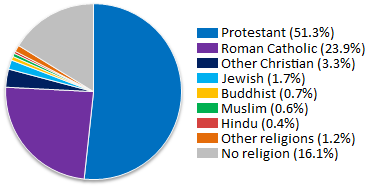Well today's post is all about holidays in America and what we recognize as a federal, local, school, or university holiday. Read this post as a response to someone complaining about why they don't get their religions holy days or holidays off as a regular thing over the holidays celebrated by Christianity, the dominant religion in America.
Let us first consider what holidays we do get off as a regular thing in our schools. I want to look at this in specific because it would seem like the majority of the complaints come from this age group. Lets kick things off with a little analysis of what days we DO get off. Here is a run down of the days the school I am currently working for gets off.
Labor Day
Yom Kippur
Columbus Day
Veterans' Day
Thanksgiving (2 days)
Winter Recess (read Christmas and New Years, 7 days)
Martin Luther King, Jr. Day
Mid-Winter Recess/ Presidents' Day (5 days)
Spring Break/ Easter and Good Friday (6 days)
Memorial Day
For a grand total of 26 days off, not too shabby. What about the holidays that this school recognizes but doesn't observe as days off?
Rosh Hashanah
Id al-Fitr
Passover (2 days)
Muslim New Year's Day
That's an extra five days, not really a big deal, but what other major holidays are left out? To figure this out, first we need to see what our major religions are here in America. To this I move to the ever-trusty Wikipedia.

According to this graph from Wikipedia, Christian religions make up an overwhelming majority of the population in this country, to the tune of 78.5%. We already celebrate most of the major Christian holidays. This makes sense, understandably, as the founding fathers of our dear country fled to America to escape religious prosecution. Huguenots, Anglicans, Dutch Reformed, Quakers, and Puritans made up the bulk of the early settlers in America, ALL escaping from persecution in Europe during the mid 1500's and early 1600's. The Roman Catholics pre-date all of these groups by settling in Puerto Rico during the late 1400's when Columbus came to this side of the pond.
So that covers why we celebrate Christian holidays, sure, but what about the rest of us?
The Jews make up the next largest religion in the United States, coming in at a whopping 1.7%. First appearing on the scene as early as the 1600's, the Jewish community really didn't make more than a ripple in the religious pool of America until the mid 1800's. The only major holidays that are not recognized by most schools and universities is Hanukkah which comes close to Christmas many years. Those eight crazy nights however are not observed as days off. The addition of those eight days to most holiday schedules of schools and uni's would bring the typical winter break to 15 days. If there are any Jewish readers who say I missed something, do let me know, I will add it to my dialog.
According to the graph I am using Buddhism is the next largest religion at a zen-like .7%. Buddhism is one of the religious late-comers to America, landing in the mid-1800's with Asian immigrants from China and elsewhere. I'm no big Buddhist buff, but from what I understand the holy days of Buddhism follow lunar cycles and beyond those monthly celebrations there are also roughly a dozen holidays. Because of my lack of knowledge I'm not going to comment further for fear of sounding like an ignorant boob.
Islam is a fast growing religion in the US, and I an almost guarantee that since the 2007 survey that pegged the Muslim population at .6% it has grown, likely overcoming Buddhism and then some. Major observances of Islam include; Ramadan, the date of which varies year to year, Ashura, Laylat al-Qadr, Laylat ul Isra and Mi'raj, Laylat ul Bara'ah, Eid al-Fitr (last day of Ramadan, 3 day feast), and Eid al-Adha (4 days). The nice thing about Muslim holidays and observances are mostly at night. The word "Laylat" means night or night of, so you can see that most of these wouldn't require a day off. Ramadan is a month of fasting and prayer, which also wouldn't require a month of days off. Both Eid's would require time off but would likely amount to something similar to a 3 or 4 day weekend. Ashura is a two day holiday that coincides with Yom Kippur. So the total count for new holidays to accommodate Muslim holidays would be as many as 8 or 9 depending on the year.
Hinduism is a very small religion in America with only .4% of the population. Hindu holidays number close to 30 and some are based on solar cycles, others are specific days of months of celebration. I am not too firm on Hinduism and its specifics so I will not comment on it however it is easy to say that the roughly 1.25 million Hindu's in American will get by with taking days off from work that they find to be of great importance.
Lastly we have a large group of Americans, the non-affiliated, who make up 16.1% of the population. Larger than any of the other groups in America. These folks, I can say with out a reasonable amount of doubt, don't really care or don't really mind not getting special holidays for them. They are probably good enough to have the days they already have off, off.
So what would it mean to accommodate all these different religions? Well to start we would need to add around 16 to 20 days to the calendar. Wow that's nearly an extra month of school off and the same tacked onto the school year to make up for it! Lets imagine the cost. I don't have good numbers on this but I remember from college hearing that the average public school tuition would work out to almost 10k per student per year. So for 180 school days, the average public school is spending about $55 per student per day. This would mean an additional $1100 per student per year, bringing the average cost per student to near $11,100 per year. The average American school district serves about 1800 students, small I know, but when you consider the number of rural districts this is understandable. Ok enough number juggling. The cost per school to observe as many holidays as politically correct, would be about 2 million dollars.
Now consider the effect this would have on districts that already cannot afford to stay open! Thousands of schools would close, thousands more teachers would be out of a job, and students would need to be crammed into classes in the remaining schools. This would not be the effect everywhere but we would see a dramatic decline in the quality of education for our students.
Take into account I haven't addressed any of the socio-political and socio-economic effects or the effects on the many aspects of American life there would be.
So can we observe the holidays of every religion here in the United States, no. Should we consider it a problem, I think not. Are there more pressing social issues that we need to address, yes our time and money and brain power should be aimed elsewhere.





No comments:
Post a Comment